Using a Multi-Proxy Approach to Detect and Date a Buried part of the Hellenistic City Wall of Ainos (NW Turkey)
Abstract
1. Introduction
2. Study Area
2.1. Geographical Setting
2.2. Historical Background
3. Material and Methods
3.1. Geoarchaeological and Geophysical Fieldwork
3.2. Local Coordinate System, Sea Level and DGPS Measurements
3.3. Sedimentology and Geochemistry
3.4. Micropalaeontology
3.5. Chronology
4. Results
4.1. Results of the Magnetic Survey
4.2. Results of the ERT Profiles
4.3. Results of the Coring Ain 53
5. Discussion
5.1. Palaeogeographical Evolution of the Area
5.1.1. Interpretation of Coring Ain 53
5.1.2. Synopsis of the Landscape Evolution
5.2. The Age of the City Wall
5.3. Detection of the Possible Extension of the Wall Course Using ERT
6. Conclusions
Author Contributions
Funding
Acknowledgments
Conflicts of Interest
References
- Al-Sibahy, A.; Edwards, R. Characterization of the clay masonry units and construction technique at the ancient city of Nippur. Eng. Struct. 2017, 147, 517–529. [Google Scholar] [CrossRef]
- Frederiksen, R. Greek City Walls of the Archaic Period, 900–480 BC; Oxford University Press: Oxford, UK, 2011; pp. 1–320. [Google Scholar]
- Leontarakis, K.; Apostolopoulos, G.V. Model Stacking (MOST) technique applied in cross-hole ERT field data for the detection of Thessaloniki ancient walls’ depth. J. Appl. Geophys. 2013, 93, 101–113. [Google Scholar] [CrossRef]
- Müth, S.; Ruppe, U. Regional begrenzte Phänomene. In Ancient Fortifications: A Compendium of Theory and Practice; Müth, S., Schneider, P., Schnelle, M., De Staebler, P., Eds.; Oxbow Books: Oxford, UK, 2016; pp. 231–248. [Google Scholar]
- Kraft, J.C.; Aschenbrenner, S.E.; Rapp, G., Jr. Paleogeographic reconstructions of coastal Aegean archeological sites. Science 1977, 195, 941–947. [Google Scholar] [CrossRef] [PubMed]
- Kraft, J.C.; Brückner, H.; Kayan, İ.; Engelmann, H. The geographies of ancient Ephesus and the Artemision in Anatolia. Geoarchaeology 2007, 22, 121–149. [Google Scholar] [CrossRef]
- Goodman, B.N.; Reinhardt, E.; Dey, H.; Boyce, J.; Schwarcz, H.; Sahoglu, V.; Erkanal, H.; Artzy, M. Evidence for Holocene marine transgression and shoreline progradation due to barrier development in Iskele, Bay of Izmir, Turkey. J. Coast. Res. 2008, 24, 1269–1280. [Google Scholar] [CrossRef]
- Goodman, B.N.; Reinhardt, E.G.; Dey, H.W.; Boyce, J.I.; Schwarcz, H.P.; Sahoglu, V.; Erkanal, H.; Artzy, M. Multi-proxy geoarchaeological study redefines understanding of the paleocoastlines and ancient harbours of Liman Tepe (Iskele, Turkey). Terra Nova 2009, 21, 97–104. [Google Scholar] [CrossRef]
- Marriner, N.; Morhange, C.; Kaniewski, D.; Carayon, N. Ancient harbour infrastructure in the Levant: tracking the birth and rise of new forms of anthropogenic pressure. Sci. Rep. 2014, 4, 5554. [Google Scholar] [CrossRef] [PubMed]
- Delile, H.; Blichert-Toft, J.; Goiran, J.P.; Stock, F.; Arnaud-Godet, F.; Bravard, J.P.; Brückner, H.; Albarède, F. Demise of a harbor: A geochemical chronicle from Ephesus. J. Archaeol. Sci. 2015, 53, 202–213. [Google Scholar] [CrossRef]
- Hadler, H.; Kissas, K.; Koster, B.; Mathes-Schmidt, M.; Mattern, T.; Ntageretzis, K.; Reicherter, K.; Willershäuser, T.; Vött, A. Multiple Late-Holocene tsunami landfall in the eastern Gulf of Corinth recorded in the palaeotsunami geoarchive at Lechaion, harbour of ancient Corinth (Peloponnese, Greece). Z. Geomorphol. 2013, 57, 139–180. [Google Scholar] [CrossRef]
- Pint, A.; Seeliger, M.; Frenzel, P.; Feuser, S.; Erkul, E.; Berndt, C.; Klein, C.; Pirson, F.; Brückner, H. The environs of Elaia’s ancient open harbour—A reconstruction based on microfaunal evidence. J. Archaeol. Sci. 2015, 54, 340–355. [Google Scholar] [CrossRef]
- Morhange, C.; Giaime, M.; Marriner, N.; abu Hamid, A.; Bruneton, H.; Honnorat, A.; Kaniewski, D.; Magni, F.; Porotov, A.V.; Wante, J.; Zviely, D.; Artzy, M. Geoarchaeological evolution of Tel Akko’s ancient harbour (Israel). J. Archaeol. Sci. Rep. 2016, 7, 71–81. [Google Scholar] [CrossRef]
- Salel, T.; Bruneton, H.; Lefèvre, D. Ostracods and environmental variability in lagoons and deltas along the north-western Mediterranean coast (Gulf of Lions, France and Ebro delta, Spain). Rev. Micropaléontol. 2016, 59, 425–444. [Google Scholar] [CrossRef]
- Evelpidou, N.; Karkani, A.; Kampolis, I.; Pirazzoli, P. Late Holocene shorelines in east Attica (Greece). Quat. Int. 2017, 436, 1–7. [Google Scholar] [CrossRef]
- Flaux, C.; Marriner, N.; el-Assal, M.; Kaniewski, D.; Morhange, C. Late Holocene erosion of the Canopic promontory (Nile Delta, Egypt). Mar. Geol. 2017, 385, 56–67. [Google Scholar] [CrossRef]
- Giaime, M.; Morhange, C.; Ontiveros, M.A.C.; Fornós, J.J.; Vacchi, M.; Marriner, N. In search of Pollentia’s southern harbour: Geoarchaeological evidence from the Bay of Alcúdia (Mallorca, Spain). Palaeogeogr. Palaeoclim. Palaeoecol. 2017, 466, 184–201. [Google Scholar] [CrossRef]
- Pennington, B.T.; Sturt, F.; Wilson, P.; Rowland, J.; Brown, A.G. The fluvial evolution of the Holocene Nile Delta. Quat. Sci. Rev. 2017, 170, 212–231. [Google Scholar] [CrossRef]
- Finkler, C.; Baika, K.; Rigakou, D.; Metallinou, G.; Fischer, P.; Hadler, H.; Emde, K.; Vött, A. Geoarchaeological investigations of a prominent quay wall in ancient Corcyra—Implications for harbour development, palaeoenvironmental changes and tectonic geomorphology of Corfu Island (Ionian Islands, Greece). Quat. Int. 2018, 473, 91–111. [Google Scholar] [CrossRef]
- Karkani, A.; Evelpidou, N.; Giaime, M.; Marriner, N.; Maroukian, H.; Morhange, C. Late Holocene palaeogeographical evolution of Paroikia Bay (Paros Island, Greece). Comptes Rendus Geosci. 2018, 350, 202–211. [Google Scholar] [CrossRef]
- Melis, R.T.; Di Rita, F.; French, C.; Marriner, N.; Montis, F.; Serreli, G.; Sulas, F.; Vacchi, M. 8000 years of coastal changes on a western Mediterranean island: A multiproxy approach from the Posada plain of Sardinia. Mar. Geol. 2018, 403, 93–108. [Google Scholar] [CrossRef]
- Seeliger, M.; Brill, D.; Feuser, S.; Bartz, M.; Erkul, E.; Kelterbaum, D.; Vött, A.; Klein, C.; Pirson, F.; Brückner, H. The Purpose and Age of Underwater Walls in the Bay of Elaia of Western Turkey: A Multidisciplinary Approach. Gearchaeology 2014, 29, 138–155. [Google Scholar] [CrossRef]
- Klasen, N.; Engel, M.; Brückner, H.; Hausleiter, A.; Intilia, A.; Eichmann, R.; al-Najem, M.; al-Said, S. Optically stimulated luminescence dating of the city wall system of ancient Tayma (NW Saudi Arabia). J. Archaeol. Sci. 2011, 38, 1818–1826. [Google Scholar] [CrossRef]
- Alpar, B. Plio-Quaternary history of the Turkish coastal zone of the Enez-Evros Delta: NE Aegean Sea. Mediterr. Mar. Sci. 2001, 2, 95–118. [Google Scholar] [CrossRef]
- Anthony, E.J.; Marriner, N.; Morhange, C. Human influence and the changing geomorphology of Mediterranean deltas and coasts over the last 6000 years: From progradation to destruction phase? Earth-Sci. Rev. 2014, 139, 336–361. [Google Scholar] [CrossRef]
- Başaran, S. The excavations at Enez (Ainos). In İstanbul University’s Contributions to Archaeology in Turkey 1932-2000; Belli, O., Ed.; İstanbul Üniversitesi: İstanbul, Turkey, 2001; pp. 219–226. [Google Scholar]
- Başaran, S. Enez (Ainos); İstanbul Üniversitesi: İstanbul, Turkey, 2010; pp. 1–132. [Google Scholar]
- Anzidei, M.; Antonioli, F.; Benini, A.; Lambeck, K.; Sivan, D.; Serpelloni, E.; Stocchi, P. Sea level change and vertical land movements since the last two millennia along the coasts of south-western Turkey and Israel. Quat. Int. 2011, 232, 13–20. [Google Scholar] [CrossRef]
- Flemming, N.C. Holocene eustatic changes and coastal tectonics in the Northeast Mediterranean: Implications for models of crustal consumption. Philos. Trans. R. Soc. Lond. Math. Phys. Sci. 1978, 289, 405–458. [Google Scholar] [CrossRef]
- Seeliger, M.; Bartz, M.; Erkul, E.; Feuser, S.; Kelterbaum, D.; Klein, C.; Pirson, F.; Vött, A.; Brückner, H. Taken from the sea, reclaimed by the sea: The fate of the closed harbour of Elaia, the maritime satellite city of Pergamum (Turkey). Quat. Int. 2013, 312, 70–83. [Google Scholar] [CrossRef]
- Seeliger, M.; Pint, A.; Frenzel, P.; Feuser, S.; Pirson, F.; Riedesel, S.; Brückner, H. Foraminifera as markers of Holocene sea-level fluctuations and water depths of ancient harbours—A case study from the Bay of Elaia (W Turkey). Palaeogeogr. Palaeoclim. Palaeoecol. 2017, 482, 17–29. [Google Scholar] [CrossRef]
- Alpar, B.; Erel, J.; Gazioglu, C.; Gokasan, E.; Adatepe, F.; Demirel, S.; Algan, O. Plio-Quaternary evolution of the Enez Delta, NE Aegean Sea. Turk. J. Mar. Sci. 1998, 4, 11–28. [Google Scholar]
- Homer. Iliad; Translated by Hampe, R., Ed.; Reclam: Leipzig, Saxony, Germany, 1986; pp. 1–622, (Greek to German). [Google Scholar]
- Başaran, S. Die Ausgrabungen in Ainos (Ein Überblick). In Thrace in the Graeco-Roman World, Proceedings of the 10th International Congress of Thracology, Komotini, Greece, 18–23 October 2005; Institute for Greek and Roman Antiquity, National Hellenic Research Foundation: Athens, Greece, 2007; pp. 72–79. [Google Scholar]
- Karadima, C. Ainos: An Unknown Amphora Production Centre in the Evros Delta. In Transport Amphorae and Trade in the Eastern Mediterranean, Proceedings of the International Colloquium, Athens, Greece, 26–29 September 2002; Eiring, J., Lund, J., Eds.; Monographs of the Danish Institute: Athens, Greece, 2004; pp. 155–161. [Google Scholar]
- Kaygusuz, I. Erzen: A stempel auf amphorenhenkeln aus Ainos (Enez). Epigr. Anatolica 1986, 7, 7–16. [Google Scholar]
- May, J.M.F. Ainos: Its History and Coinage, 474–341 B.C.; University Press: London, UK, 1950; pp. 1–288. [Google Scholar]
- Strack, M.L. Die antiken Münzen von Dacien und Moesien. In Die antiken Münzen Nord-Griechenlands; Druck und verla von Georg Reimer: Berlin, Germany, 1898; p. 69. [Google Scholar]
- Casson, S. Macedonia, Thrace, and Illyria: Their Relations to Greece from the Earliest Times Down to the Time of Philip, Son of Amyntas; Oxford University Press: Oxford, UK, 1926; pp. 1–21. [Google Scholar]
- Isaac, B.H. The Greek Settlements in Thrace until the Macedonian Conquest; Brill: Leiden, The Netherlands, 1986; pp. 1–306. [Google Scholar]
- Lätzer-Lasar, A. Das römische Handelsnetz von Ainos: Ausgewählte Keramik vom Späthellenismus bis zur Spätantike. Rei Cretariae Romanae Fautorum Acta 2016, 44, 707–714. [Google Scholar]
- Soustal, P. Thrakien (Thrake, Rodope, Haimimontos); Austrian Academy of Sciences: Vienna, Austria, 1991; pp. 1–580. [Google Scholar]
- Procopius. On Buildings; Translated by Dewing, H.B., Downey, G., Eds.; Harvard University Press: Cambridge, MA, USA, 1949; pp. 1–561, (Greek to English). [Google Scholar]
- Avreamea, A. Land and Sea Communications, Fourth–Fifteenth Centuries. In Economic History of Byzantium: From the Seventh through the Fifteenth Century; Laiou, A., Ed.; Dumbarton Oaks: Washington, DC, USA, 2002; pp. 57–90. [Google Scholar]
- Matschke, K.P. Commerce, Trade, Markets, and Money, Thirteenth—Fifteenth Centuries. In Economic History of Byzantium: From the Seventh through the Fifteenth Century; Laiou, A., Ed.; Dumbarton Oaks: Washington, DC, USA, 2002; pp. 771–806. [Google Scholar]
- Makris, G. Ships. In Economic History of Byzantium: From the Seventh through the Fifteenth Century; Laiou, A., Ed.; Dumbarton Oaks: Washington, DC, USA, 2002; pp. 91–100. [Google Scholar]
- Qusterhout, R. The Byzantine Church at Enez. Problems in Twelfth-Century Architecture. Jahrb. Österr. Byzantistik 1985, 35, 261–280. [Google Scholar]
- Ousterhout, R.; Bakirtzis, Ch. The Byzantine Monuments of the Evros/Meriç River Valley; European Center for Byzantine and Post-Byzantine Monuments: Thessaloniki, Greece, 2007; pp. 1–184. [Google Scholar]
- Loke, M.H.; Barker, R.D. Least-squares deconvolution of apparent resistivity pseudo-sections. Geophysics 1995, 60, 1682–1690. [Google Scholar] [CrossRef]
- Engel, M.; Knipping, M.; Brückner, H.; Kiderlen, M.; Kraft, J.C. Reconstructing middle to late Holocene palaeogeographies of the lower Messenian plain (southwestern Peloponnese, Greece): Coastline migration, vegetation history and sea level change. Paleogeogr. Paleoclim. Paleoecol. 2009, 284, 257–270. [Google Scholar] [CrossRef]
- Ernst, W. Geochemical Facies Analysis; Elsevier: Amsterdam, The Netherlands, 1970; pp. 1–158. [Google Scholar]
- Folk, R.L.; Ward, W.C. Brazos River bar: A study in the significance of grain size parameters. J. Sediment. Petrol. 1957, 27, 3–26. [Google Scholar] [CrossRef]
- Blott, S.J.; Pye, K. GRADISTAT: a grain size distribution and statistics package for the analysis of unconsolidated sediments. Earth Surf. Process. Landf. 2001, 26, 1237–1248. [Google Scholar] [CrossRef]
- Mook, D.H.; Hoskin, C.M. Organic determinations by ignition: Caution advised. Estuar. Coast. Shelf Sci. 1982, 15, 697–699. [Google Scholar] [CrossRef]
- Heiri, O.; Lotter, A.F.; Lemcke, G. Loss on ignition as a method for estimating organic and carbonate content in sediments: reproducibility and comparability of results. J. Paleolimnol. 2001, 25, 101–110. [Google Scholar] [CrossRef]
- Dankers, N.; Laane, R. A comparison of wet oxidation and loss on ignition of organic material in suspended matter. Environ. Technol. Lett. 1983, 834, 283–290. [Google Scholar] [CrossRef]
- Salehi, M.H.; Hashemi, B.O.; Bigi, H.H.; Esfandiarpour, B.I.; Motaghian, H.R. Refining soil organic matter determination by loss-on-ignition. Pedosphere 2011, 21, 473–482. [Google Scholar] [CrossRef]
- Vött, A.; Bareth, G.; Brückner, H.; Lang, F.; Sakellariou, D.; Hadler, H.; Ntageretzis, K.; Willershäuser, T. Olympia’s harbour site Pheia (Elis, Western Peloponnese, Greece) destroyed by tsunami impact. Die Erde 2011, 142, 259–288. [Google Scholar]
- Lubos, C.; Dreibrodt, S.; Bahr, A. Analysing spatio-temporal patterns of archaeological soils and sediments by comparing pXRF and different ICP-OES extraction methods. J. Archaeol. Sci. Rep. 2016, 9, 44–53. [Google Scholar] [CrossRef]
- Cimerman, F.; Langer, M.R. Mediterranean foraminifera. Slovenska Akademija Znanosti in Umetnosti; Academia Scientarium et Artium Slovenca: Ljubliana, Slovenia, 1991; pp. 1–118. [Google Scholar]
- Meriç, E.; Avsar, N.; Bergin, F. Benthic foraminifera of eastern Aegean Sea (Turkey); systematics and autoecology. Turkish Mar. Res. Found. 2004, 18, 1–306. [Google Scholar]
- Reimer, P.J.; Bard, E.; Bayliss, A.; Beck, J.W.; Blackwell, P.G.; Bronk Ramsey, C.; Buck, C.E.; Cheng, H.; Edwards, R.L.; Friedrich, M.; et al. IntCal13 and MARINE13 radiocarbon age calibration curves 0-50000 years calBP. Radiocarbon 2013, 55, 1869–1887. [Google Scholar] [CrossRef]
- Siani, G.; Paterne, M.; Arnold, M.; Bard, E.; Metivier, B.; Tisnerat, N.; Bassinot, F. Radiocarbon reservoir ages in the Mediterranean Sea and Black Sea. Radiocarbon 2000, 42, 271–280. [Google Scholar] [CrossRef]
- Ramsey, C.B. Deposition models for chronological records. Quat. Sci. Rev. 2008, 27, 42–60. [Google Scholar] [CrossRef]
- Lehmann, K. Samothrace: A Guide to the Excavations and the Museum. Institute of Fine Art; New York University: Thessaloniki, Greece, 1998; pp. 1–184. [Google Scholar]
- Winter, F.E. The Indented Trace in Later Greek Fortifications. Am. J. Archaeol. 1971, 75, 413–426. [Google Scholar] [CrossRef]
- Winter, F.E. Greek Fortifications; Routledge & Kegan Paul: London, UK, 1971; pp. 1–388. [Google Scholar]
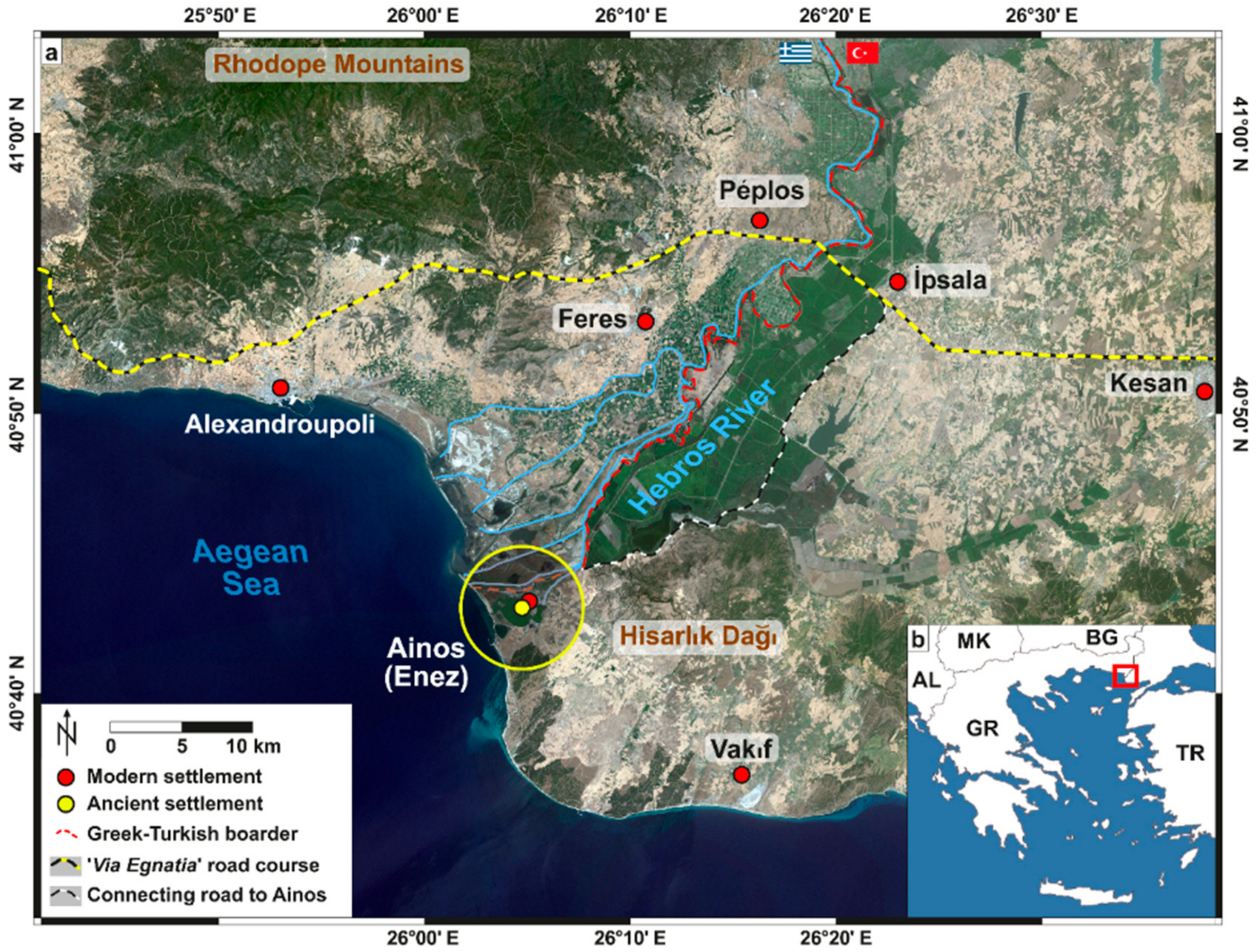
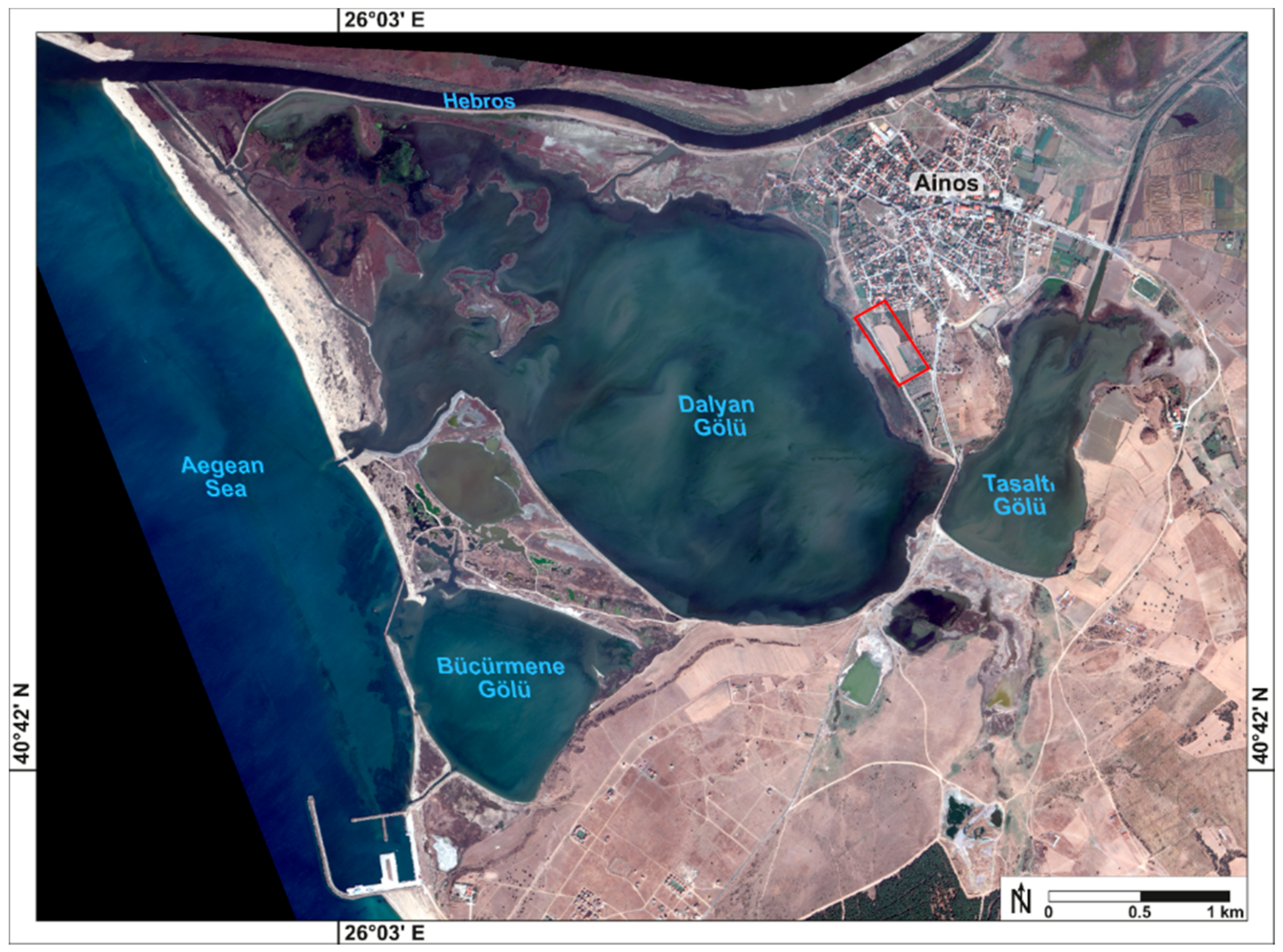
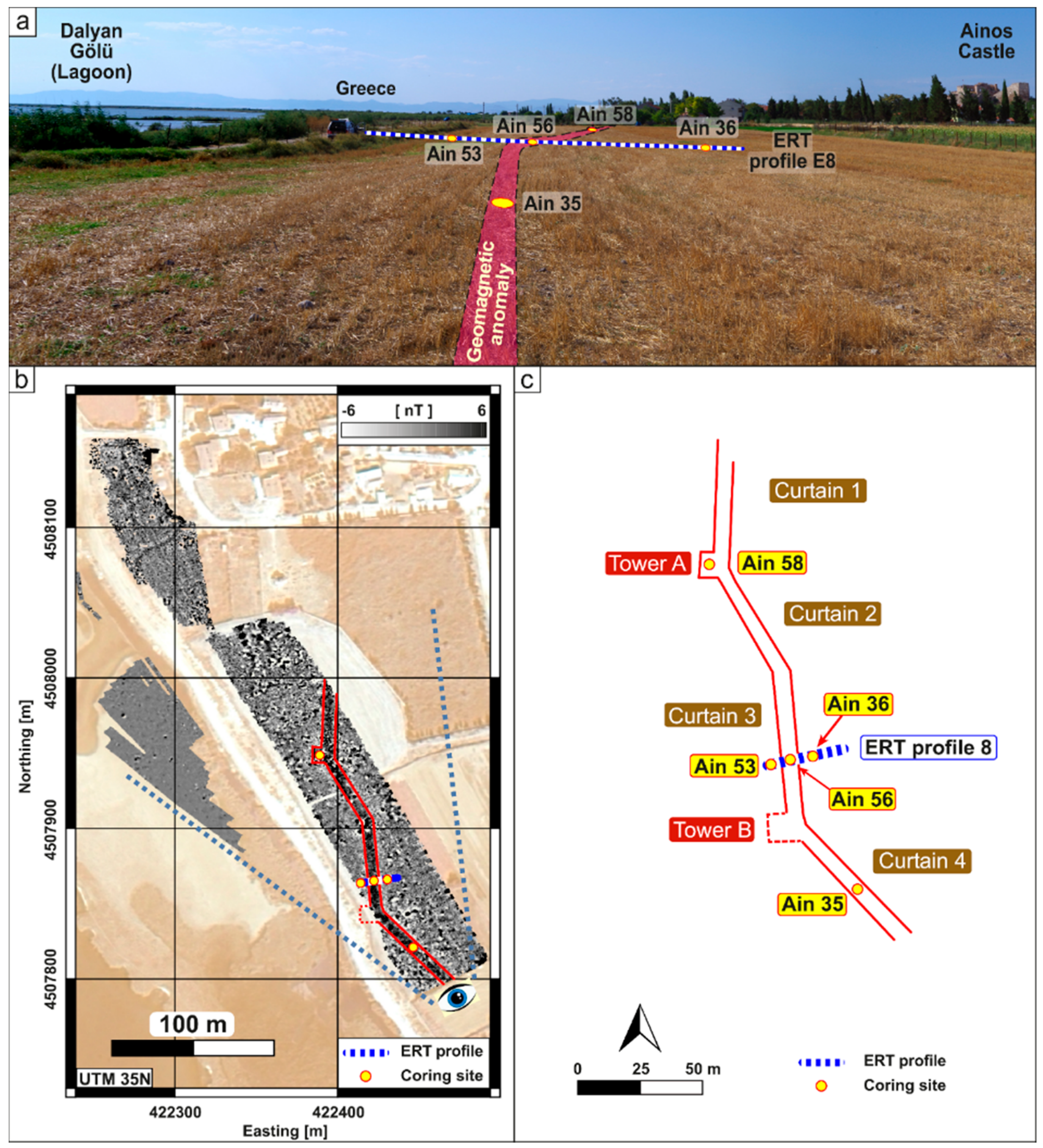
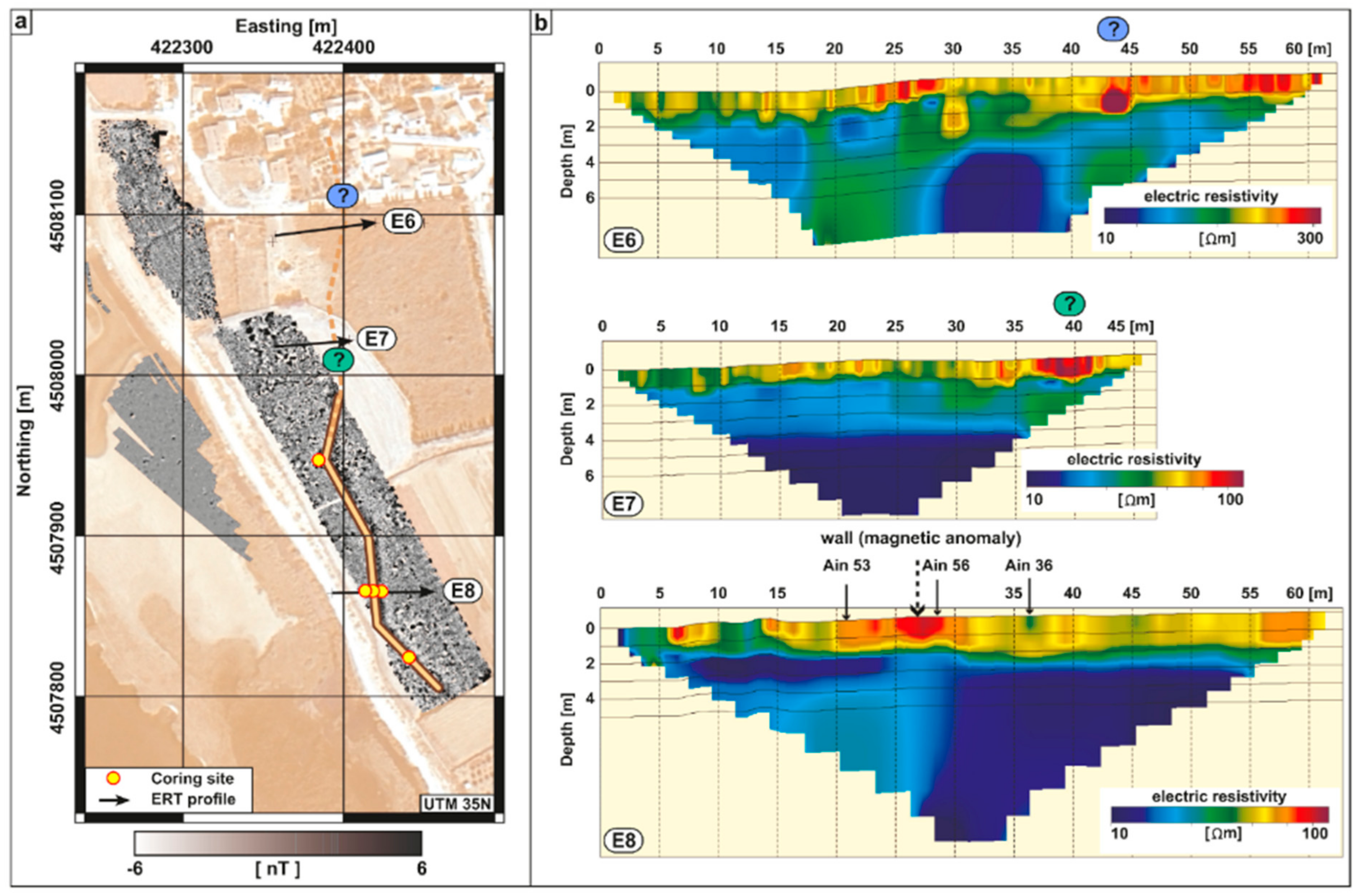
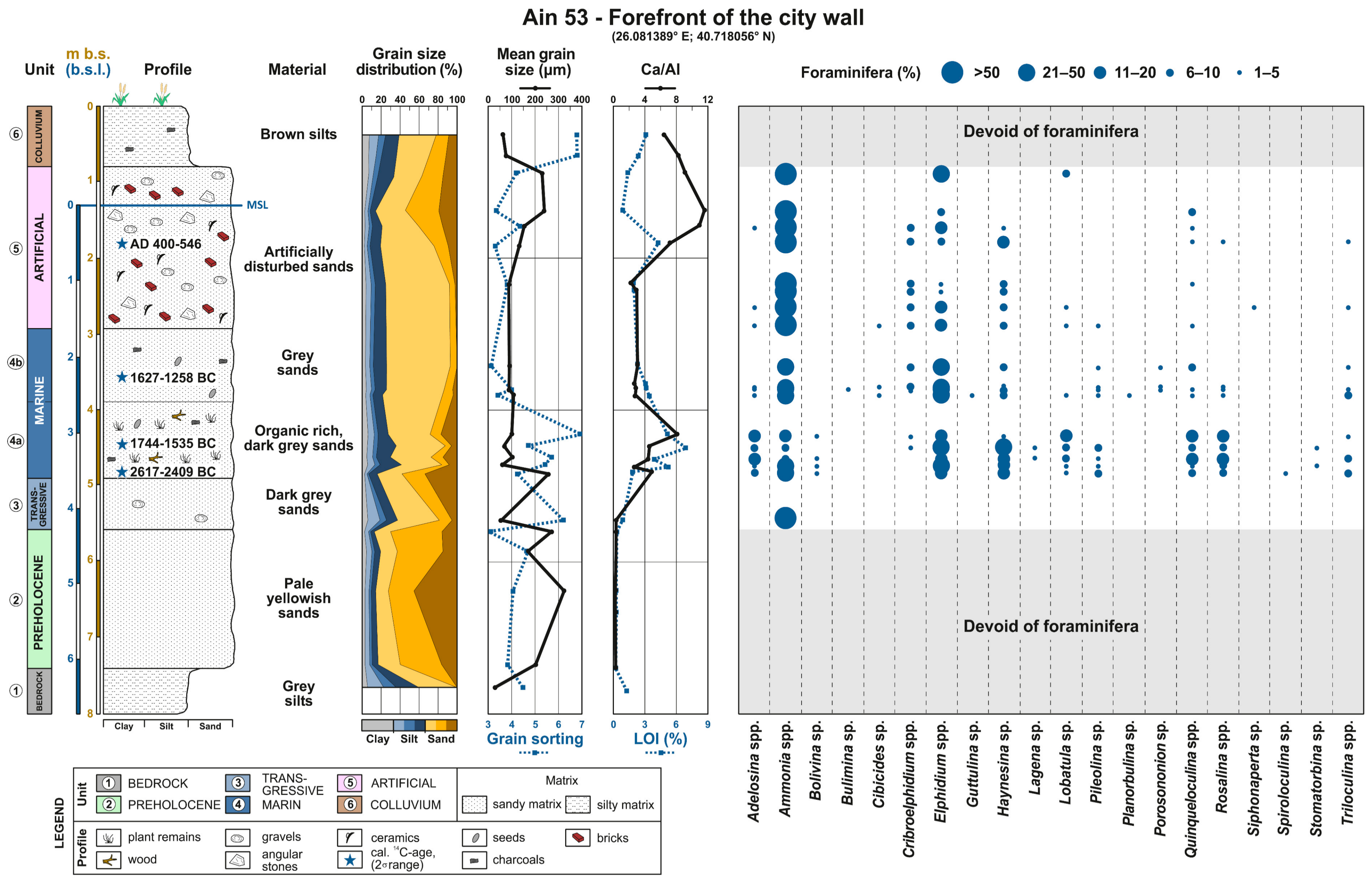
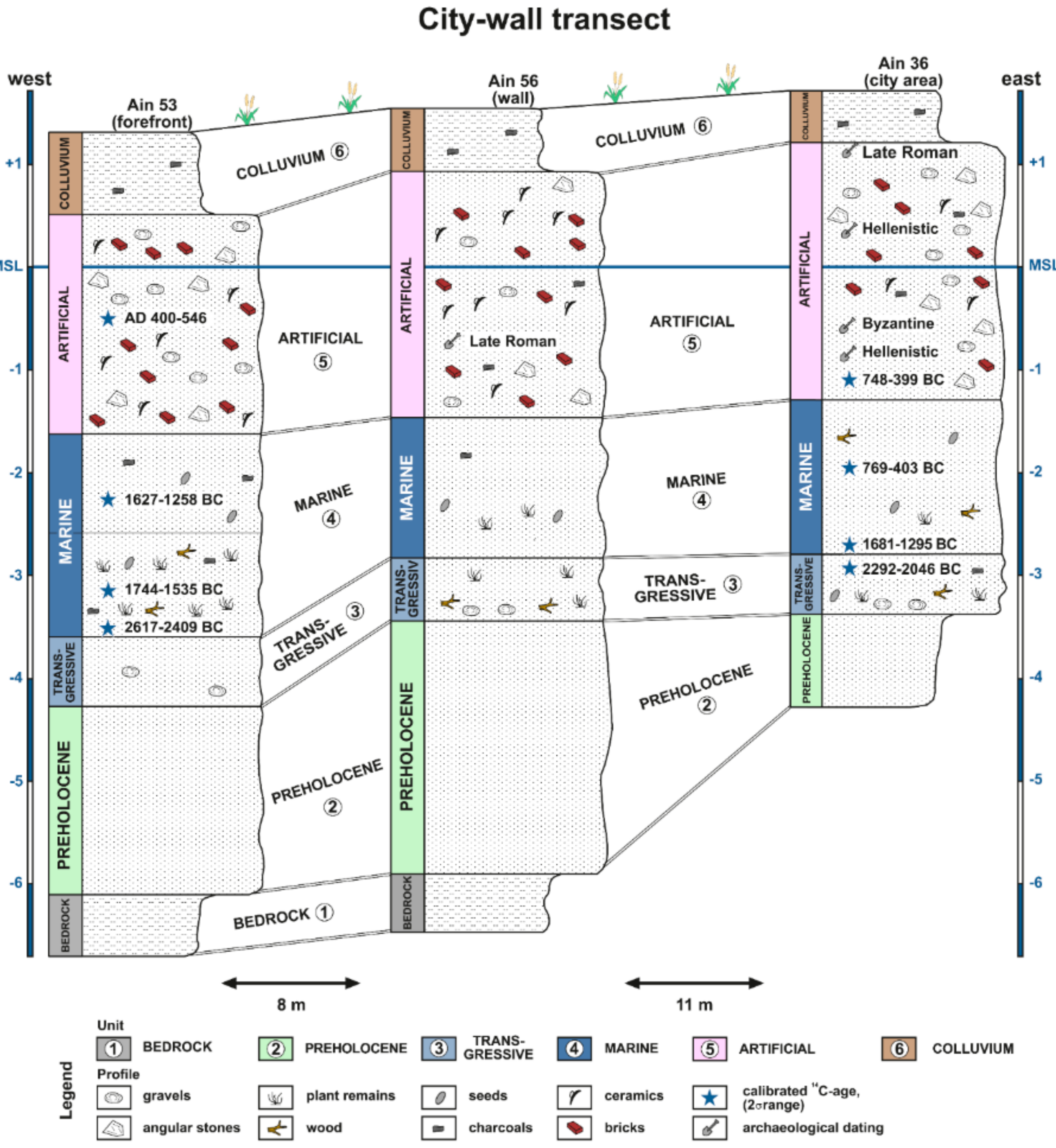
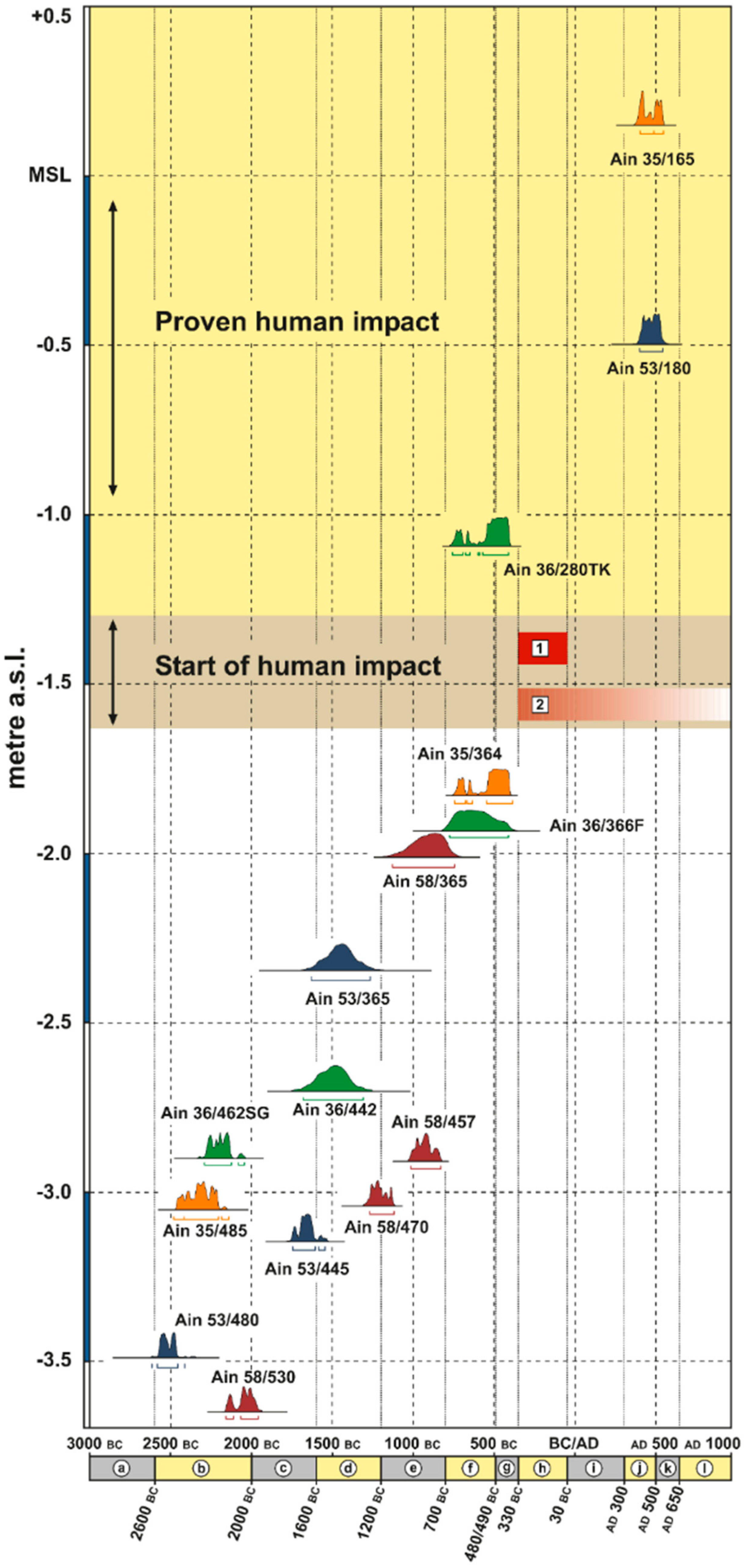
| Depth b.s. (m) | Depth b.s.l. (m)/a.s.l. (m) | d13C (‰) | Libby-Age | Calibrated 14C Ages Cal BC/Cal AD (2σ) | Calibrated 14C Ages Cal BP (2σ) |
|---|---|---|---|---|---|
| 1.65 | 0.14 a.s.l. | −22.8 | 1610 ± 24 | AD 395–536 | 1414–1555 BP |
| 3.64 | 1.85 b.s.l. | −23.3 | 2424 ± 28 | 747–404 BC | 2353-2696 BP |
| 4.85 | 3.06 b.s.l. | −12.1 | 3847 ± 33 | 2457–2205 BC | 4154–4406 BP |
| 6.75 | 4.96 b.s.l. | −9.6 | 3893 ± 30 | 2468–2293 BC | 4242–4417 BP |
| 2.80 | 1.08 b.s.l. | −25.6 | 2413 ± 35 | 748–399 BC | 2348–2697 BP |
| 3.66 | 1.94 b.s.l. | 0.2 | 2847 ± 22 | 769–403 BC | 2352–2718 BP |
| 4.42 | 2.70 b.s.l. | −15.8 | 3585 ± 33 | 1681–1295 BC | 3244–3630 BP |
| 4.62 | 2.90 b.s.l. | −11.4 | 3779 ± 33 | 2292-2046 BC | 3995–4241 BP |
| 1.80 | 0.49 b.s.l. | −22.3 | 1588 ± 34 | AD 400–546 | 1404–1550 BP |
| 3.65 | 2.34 b.s.l. | 3.2 | 3547 ± 24 | 1627–1258 BC | 3207–3576 BP |
| 4.45 | 3.14 b.s.l. | −10.7 | 3364 ± 34 | 1744–1535 BC | 3484–3693 BP |
| 4.80 | 3.49 b.s.l. | −11.6 | 3988 ± 34 | 2617–2409 BC | 4358–4566 BP |
| 3.65 | 1.98 b.s.l. | 3.1 | 3102 ± 33 | 1097–755 BC | 2704–3046 BP |
| 4.57 | 2.90 b.s.l. | −16.6 | 2779 ± 32 | 1004–842 BC | 2791–2953 BP |
| 4.70 | 3.03 b.s.l. | −15.0 | 2985 ± 26 | 1285–1120 BC | 3069–3234 BP |
| 5.30 | 3.63 b.s.l. | −17.3 | 3651 ± 28 | 2134–1941 BC | 3890–4083 BP |
© 2018 by the authors. Licensee MDPI, Basel, Switzerland. This article is an open access article distributed under the terms and conditions of the Creative Commons Attribution (CC BY) license (http://creativecommons.org/licenses/by/4.0/).
Share and Cite
Seeliger, M.; Pint, A.; Frenzel, P.; Weisenseel, P.K.; Erkul, E.; Wilken, D.; Wunderlich, T.; Başaran, S.; Bücherl, H.; Herbrecht, M.; et al. Using a Multi-Proxy Approach to Detect and Date a Buried part of the Hellenistic City Wall of Ainos (NW Turkey). Geosciences 2018, 8, 357. https://doi.org/10.3390/geosciences8100357
Seeliger M, Pint A, Frenzel P, Weisenseel PK, Erkul E, Wilken D, Wunderlich T, Başaran S, Bücherl H, Herbrecht M, et al. Using a Multi-Proxy Approach to Detect and Date a Buried part of the Hellenistic City Wall of Ainos (NW Turkey). Geosciences. 2018; 8(10):357. https://doi.org/10.3390/geosciences8100357
Chicago/Turabian StyleSeeliger, Martin, Anna Pint, Peter Frenzel, Paula K. Weisenseel, Ercan Erkul, Dennis Wilken, Tina Wunderlich, Sait Başaran, Heike Bücherl, Marina Herbrecht, and et al. 2018. "Using a Multi-Proxy Approach to Detect and Date a Buried part of the Hellenistic City Wall of Ainos (NW Turkey)" Geosciences 8, no. 10: 357. https://doi.org/10.3390/geosciences8100357
APA StyleSeeliger, M., Pint, A., Frenzel, P., Weisenseel, P. K., Erkul, E., Wilken, D., Wunderlich, T., Başaran, S., Bücherl, H., Herbrecht, M., Rabbel, W., Schmidts, T., Szemkus, N., & Brückner, H. (2018). Using a Multi-Proxy Approach to Detect and Date a Buried part of the Hellenistic City Wall of Ainos (NW Turkey). Geosciences, 8(10), 357. https://doi.org/10.3390/geosciences8100357





